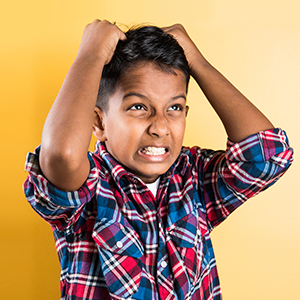It’s normal and even helpful to worry on occasion, but what should parents
do when anxiety becomes more frequent and troubling? Psychologist Lawrence
J. Cohen, Ph.D. has explored this question in two highly regarded books,
“Playful Parenting” and “The Opposite of Worry,” which have been translated
into 14 languages. Dr. Cohen talks with Katherine Reynolds Lewis about how
parents can manage the recent surge in childhood anxiety.
Q: Do you see more children experiencing anxiety?
A: I’ve seen a big increase in childhood anxiety and parental anxiety, and
of course they go together. I’ve observed a big increase since 9-11. That
coincides with higher pace, faster pace, being constantly connected. It’s
great for a lot of things, but it’s not great for being calm or centered or
having down time.
There are things that 20 or 30 years ago, parents would have rushed to some
mental health intervention, but now it’s seen as kind of normal. I don’t
think that’s because people are calmer about things. It’s just become the
norm. I see children as old as eleven who can’t be in a room in the house
by themselves. Children in school or other stressful situations will chew
on their shirts or not be able to sit still or focus.
Q: What’s driving the increase in anxiety?
A: There has always been 15 to 20 percent of children who are slow to warm
up, who have an intense reaction to anything new. Some of these kids end up
being shy or socially anxious. Then there’s another group of children who
have experienced trauma and have anxiety for that reason. Their nervous
systems are always on alert. Then there are anxious parents. The anxiety is
contagious in both directions. The economy is a big factor. There’s a big
uneasiness and a real fear that if you’re not at the top, you’re in the
gutter and there’s not enough to go around.
Q: What helps?
A: Parents should look deeply inside themselves. Am I an anxious person? If
so, how can I take care of this? It could be meditation or yoga or therapy.
It could be becoming disciplined about putting the phone away because it’s
agitating, and making sure you have actual downtime. Time with the phone or
screen does not count as downtime. That was different 20 or 30 years ago.
You would sit and veg out in front of the TV. It’s more interactive now,
which is a good thing, but it’s not downtime. We need more time just
hanging out. Parents need this, children need this and families need this.
No agenda, no pressure.
To help children, the most important thing parents can do is stop trying to
use reason and logic. The child’s anxious brain cannot make sense of that.
It needs primal soothing. Hold them in your arms, comfort them. Rebuild
that sense of security. It’s conveying, “I’m here, you’re here, we’re going
to get through this.” Anxious children need a lot of connection. Parents
want to know the short cuts. How do I get them not to sit on my lap at the
birthday party? But children who are slow to warm up need time. If you
embrace that and let them sit as long as they want, as long as they need,
they may get up sooner than if you pushed them away. When they’re ready on
their own, they will actually thrive better.
Similar to that is acknowledging children’s worries and fears. We don’t
want them to suffer, but it’s not our job to say, “Don’t worry about that.”
The effect is actually invalidating. Children can’t move forward with a
fear or worry unless they feel validated. That doesn’t mean saying, “You’re
right, your teacher hates you.” Instead, say, “That’s such a painful
thought. I can totally understand feeling like you wouldn’t want to go to
school. Let’s really talk and work on it.”
Ask children to rate the intensity of their emotions on a scale of 1 to 10.
Ask if they can describe the physical sensations and get specific: “How
many butterflies?” The evaluation of a number activates a part of the brain
that isn’t activated if you say, “Don’t worry about that stuff.” Either
they can’t stop, or they stop and go inward and are still afraid.
Children and parents can be very serious about these worries and not think
enough about play. There’s play where the child gets to be strong and
brave, or the child gets to be scary and the adult gets to be scared. These
role reversals really help. For older children you can do role plays, act
things out. This is not a teaching exercise. It’s an emotion-releasing
exercise, a tension-releasing exercise. The goal is laughter to reduce the
tension. Play, language and metaphor are symbolic forms of expression and
they add another layer of brain activity, so the anxiety isn’t the only
thing going on in the brain.
At the age of 4, 5, or 6, kids can do guided imagery with you. Help them
picture a safe place. At the age of 8, 9 or 10, talking is definitely not
going to help. They need to breathe slowly or jump up and down and scream.
All mammals have the reflex of slowing the heart when the body is immersed
in water. You can stimulate that with a plastic bag of ice water on the
forehead, covering the eyes and top of the nose, or by immersing the face
in cold water.
Q: How do you help your kids be ready to handle stress when you’re not
there?
I always teach relaxation. First practice 30 to 60 minutes of deep
relaxation several times. Then you are relaxed and can do a 10-second
relaxation. For older children, I have them make a list of their anxious
thoughts and then think through the contradictions.

